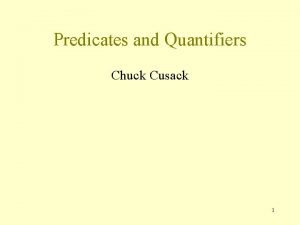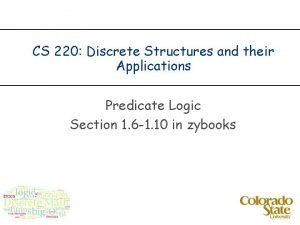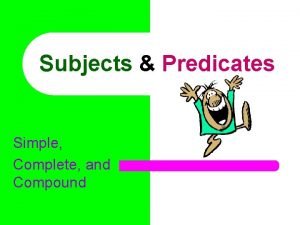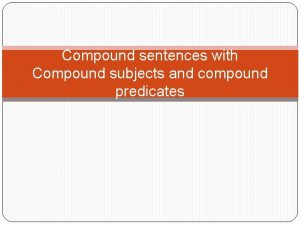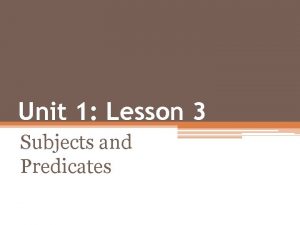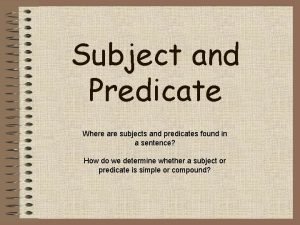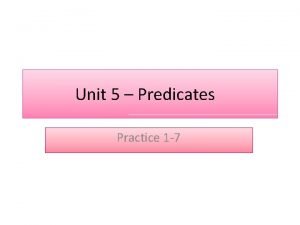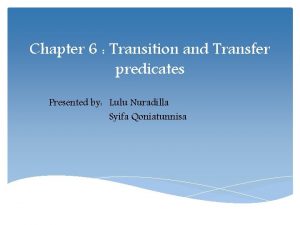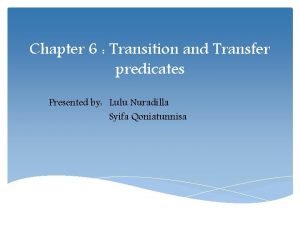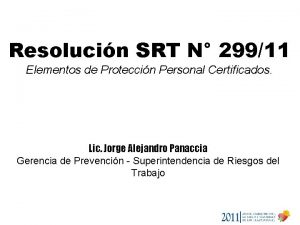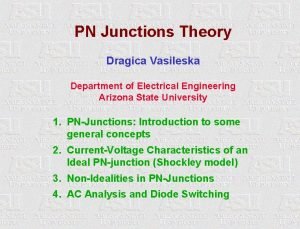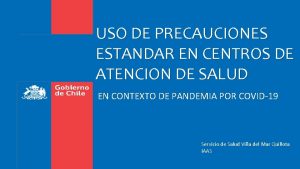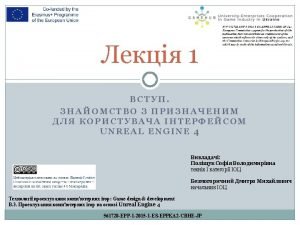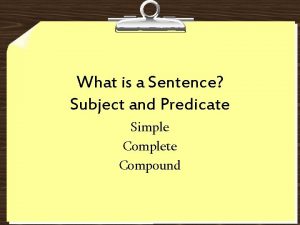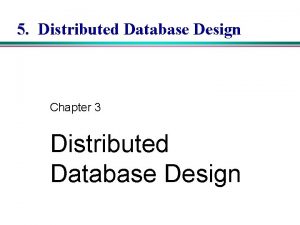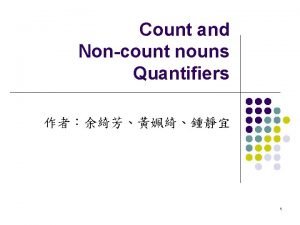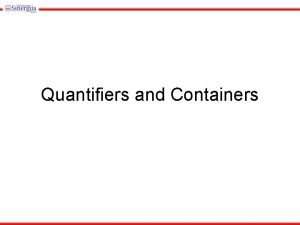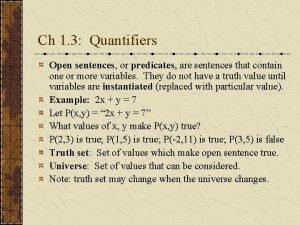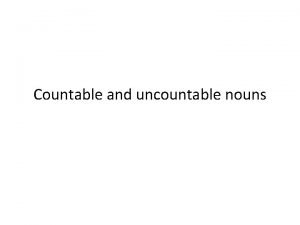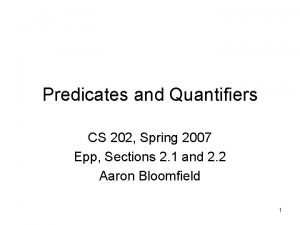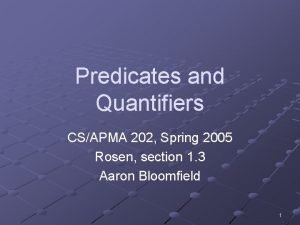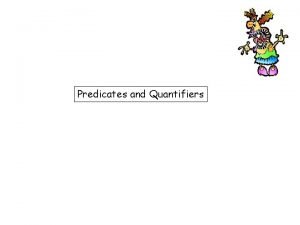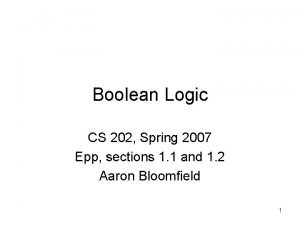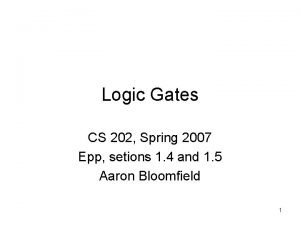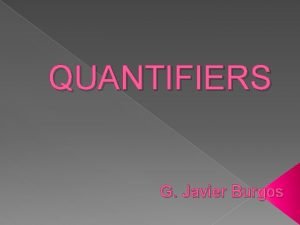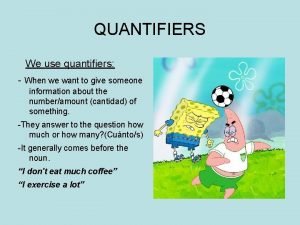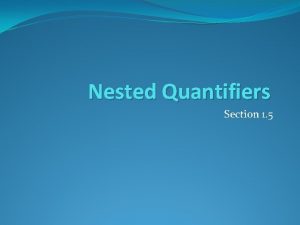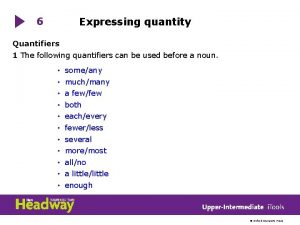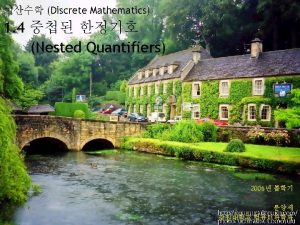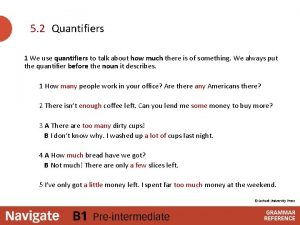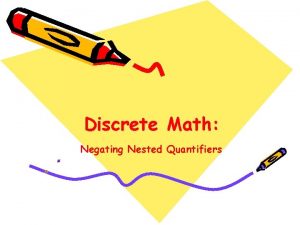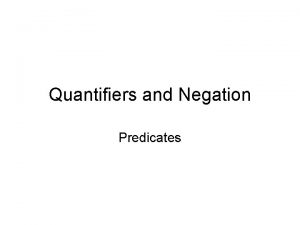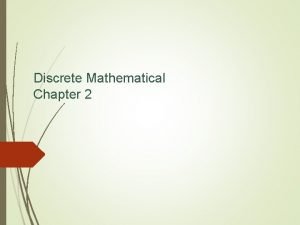Predicates and Quantifiers CS 202 Spring 2007 Epp














































- Slides: 46

Predicates and Quantifiers CS 202, Spring 2007 Epp, Sections 2. 1 and 2. 2 Aaron Bloomfield 1

Terminology review • Proposition: a statement that is either true or false – Must always be one or the other! – Example: “The sky is red” – Not a proposition: x + 3 > 4 • Boolean variable: A variable (usually p, q, r, etc. ) that represents a proposition 2

Propositional functions • Consider P(x) = x < 5 – P(x) has no truth values (x is not given a value) – P(1) is true • The proposition 1<5 is true – P(10) is false • The proposition 10<5 is false • Thus, P(x) will create a proposition when given a value 3

Propositional functions 2 • Let P(x) = “x is a multiple of 5” – For what values of x is P(x) true? • Let P(x) = x+1 > x – For what values of x is P(x) true? • Let P(x) = x + 3 – For what values of x is P(x) true? 4

Anatomy of a propositional function P(x) = x + 5 > x variable predicate 5

Propositional functions 3 • Functions with multiple variables: – P(x, y) = x + y == 0 • P(1, 2) is false, P(1, -1) is true – P(x, y, z) = x + y == z • P(3, 4, 5) is false, P(1, 2, 3) is true – P(x 1, x 2, x 3 … xn) = … 6

So, why do we care about quantifiers? • Many things (in this course and beyond) are specified using quantifiers – In some cases, it’s a more accurate way to describe things than Boolean propositions 7

Quantifiers • A quantifier is “an operator that limits the variables of a proposition” • Two types: – Universal – Existential 8

Universal quantifiers 1 • Represented by an upside-down A: – It means “for all” – Let P(x) = x+1 > x • We can state the following: – x P(x) – English translation: “for all values of x, P(x) is true” – English translation: “for all values of x, x+1>x is true” 9

Universal quantifiers 2 • But is that always true? – x P(x) • Let x = the character ‘a’ – Is ‘a’+1 > ‘a’? • Let x = the state of Virginia – Is Virginia+1 > Virginia? • You need to specify your universe! – What values x can represent – Called the “domain” or “universe of discourse” by the textbook 10

Universal quantifiers 3 • Let the universe be the real numbers. – Then, x P(x) is true • Let P(x) = x/2 < x – Not true for the negative numbers! – Thus, x P(x) is false • When the domain is all the real numbers • In order to prove that a universal quantification is true, it must be shown for ALL cases • In order to prove that a universal quantification is false, it must be shown to be false for only ONE case 11

Universal quantification 4 • Given some propositional function P(x) • And values in the universe x 1. . xn • The universal quantification x P(x) implies: P(x 1) P(x 2) … P(xn) 12

Universal quantification 5 • Think of as a for loop: • x P(x), where 1 ≤ x ≤ 10 • … can be translated as … for ( x = 1; x <= 10; x++ ) is P(x) true? • If P(x) is true for all parts of the for loop, then x P(x) – Consequently, if P(x) is false for any one value of the for loop, then x P(x) is false 13

Existential quantification 1 • Represented by an bacwards E: – It means “there exists” – Let P(x) = x+1 > x • We can state the following: – x P(x) – English translation: “there exists (a value of) x such that P(x) is true” – English translation: “for at least one value of x, x+1>x is true” 14

Existential quantification 2 • Note that you still have to specify your universe – If the universe we are talking about is all the states in the US, then x P(x) is not true • Let P(x) = x+1 < x – There is no numerical value x for which x+1<x – Thus, x P(x) is false 15

Existential quantification 3 • Let P(x) = x+1 > x – There is a numerical value for which x+1>x • In fact, it’s true for all of the values of x! – Thus, x P(x) is true • In order to show an existential quantification is true, you only have to find ONE value • In order to show an existential quantification is false, you have to show it’s false for ALL values 16

Existential quantification 4 • Given some propositional function P(x) • And values in the universe x 1. . xn • The existential quantification x P(x) implies: P(x 1) P(x 2) … P(xn) 17

A note on quantifiers • Recall that P(x) is a propositional function – Let P(x) be “x == 0” • Recall that a proposition is a statement that is either true or false – P(x) is not a proposition • There are two ways to make a propositional function into a proposition: – Supply it with a value • For example, P(5) is false, P(0) is true – Provide a quantifiaction • For example, x P(x) is false and x P(x) is true – Let the universe of discourse be the real numbers 18

Binding variables • Let P(x, y) be x > y • Consider: x P(x, y) – This is not a proposition! – What is y? • If it’s 5, then x P(x, y) is false • If it’s x-1, then x P(x, y) is true • Note that y is not “bound” by a quantifier 20

Binding variables 2 • ( x P(x)) Q(x) – The x in Q(x) is not bound; thus not a proposition • ( x P(x)) ( x Q(x)) – Both x values are bound; thus it is a proposition • ( x P(x) Q(x)) ( y R(y)) – All variables are bound; thus it is a proposition • ( x P(x) Q(y)) ( y R(y)) – The y in Q(y) is not bound; this not a proposition 21

Negating quantifications • Consider the statement: – All students in this class have red hair • What is required to show the statement is false? – There exists a student in this class that does NOT have red hair • To negate a universal quantification: – You negate the propositional function – AND you change to an existential quantification – ¬ x P(x) = x ¬P(x) 22

Negating quantifications 2 • Consider the statement: – There is a student in this class with red hair • What is required to show the statement is false? – All students in this class do not have red hair • Thus, to negate an existential quantification: – Tou negate the propositional function – AND you change to a universal quantification – ¬ x P(x) = x ¬P(x) 23

Translating from English • Consider “For every student in this class, that student has studied calculus” • Rephrased: “For every student x in this class, x has studied calculus” – Let C(x) be “x has studied calculus” – Let S(x) be “x is a student” • x C(x) – True if the universe of discourse is all students in this class 24

Translating from English 2 • What about if the unvierse of discourse is all students (or all people? ) – x (S(x) C(x)) • This is wrong! Why? – x (S(x)→C(x)) • Another option: – Let Q(x, y) be “x has stuided y” – x (S(x)→Q(x, calculus)) 25

Translating from English 3 • Consider: – “Some students have visited Mexico” – “Every student in this class has visited Canada or Mexico” • Let: – S(x) be “x is a student in this class” – M(x) be “x has visited Mexico” – C(x) be “x has visited Canada” 26

Translating from English 4 • Consider: “Some students have visited Mexico” – Rephrasing: “There exists a student who has visited Mexico” • x M(x) – True if the universe of discourse is all students • What about if the universe of discourse is all people? – x (S(x) → M(x)) • This is wrong! Why? – x (S(x) M(x)) 27

Translating from English 5 • Consider: “Every student in this class has visited Canada or Mexico” • x (M(x) C(x) – When the universe of discourse is all students • x (S(x)→(M(x) C(x)) – When the universe of discourse is all people • Why isn’t x (S(x) (M(x) C(x))) correct? 28

Translating from English 6 • Note that it would be easier to define V(x, y) as “x has visited y” – x (S(x) V(x, Mexico)) – x (S(x)→(V(x, Mexico) V(x, Canada)) 29

Translating from English 7 • Translate the statements: – – “All hummingbirds are richly colored” “No large birds live on honey” “Birds that do not live on honey are dull in color” “Hummingbirds are small” • Assign our propositional functions – – Let P(x) be “x is a hummingbird” Let Q(x) be “x is large” Let R(x) be “x lives on honey” Let S(x) be “x is richly colored” • Let our universe of discourse be all birds 30

Translating from English 8 • Our propositional functions – – Let P(x) be “x is a hummingbird” Let Q(x) be “x is large” Let R(x) be “x lives on honey” Let S(x) be “x is richly colored” • Translate the statements: – “All hummingbirds are richly colored” • x (P(x)→S(x)) – “No large birds live on honey” • ¬ x (Q(x) R(x)) • Alternatively: x (¬Q(x) ¬R(x)) – “Birds that do not live on honey are dull in color” • x (¬R(x) → ¬S(x)) – “Hummingbirds are small” • x (P(x) → ¬Q(x)) 31

Prolog • A programming language using logic! • Entering facts: instructor (bloomfield, cs 202) enrolled (alice, cs 202) enrolled (bob, cs 202) enrolled (claire, cs 202) • Entering predicates: teaches (P, S) : - instructor (P, C), enrolled (S, C) • Extracting data ? enrolled (alice, cs 202) • Result: yes 32

Prolog 2 • Extracting data ? enrolled (X, cs 202) • Result: alice bob claire • Extracting data ? teaches (X, alice) • Result: bloomfield 33

Multiple quantifiers • You can have multiple quantifiers on a statement • x y P(x, y) – “For all x, there exists a y such that P(x, y)” – Example: x y (x+y == 0) • x y P(x, y) – There exists an x such that for all y P(x, y) is true” – Example: x y (x*y == 0) 34

Order of quantifiers • x y and x y are not equivalent! • x y P(x, y) – P(x, y) = (x+y == 0) is false • x y P(x, y) – P(x, y) = (x+y == 0) is true 35

Negating multiple quantifiers • Recall negation rules for single quantifiers: – ¬ x P(x) = x ¬P(x) – Essentially, you change the quantifier(s), and negate what it’s quantifying • Examples: – ¬( x y P(x, y)) = x ¬ y P(x, y) = x y ¬P(x, y) – ¬( x y z P(x, y, z)) = x¬ y z P(x, y, z) = x y¬ z P(x, y, z) = x y z ¬P(x, y, z) 36

Negating multiple quantifiers 2 • Consider ¬( x y P(x, y)) = x y ¬P(x, y) – The left side is saying “for all x, there exists a y such that P is true” – To disprove it (negate it), you need to show that “there exists an x such that for all y, P is false” • Consider ¬( x y P(x, y)) = x y ¬P(x, y) – The left side is saying “there exists an x such that for all y, P is true” – To disprove it (negate it), you need to show that “for all x, there exists a y such that P is false” 38

Translating between English and quantifiers • The product of two negative integers is positive – x y ((x<0) (y<0) → (xy > 0)) – Why conditional instead of and? • The average of two positive integers is positive – x y ((x>0) (y>0) → ((x+y)/2 > 0)) • The difference of two negative integers is not necessarily negative – x y ((x<0) (y<0) (x-y≥ 0)) – Why and instead of conditional? • The absolute value of the sum of two integers does not exceed the sum of the absolute values of these integers – x y (|x+y| ≤ |x| + |y|) 39

Translating between English and quantifiers • x y (x+y = y) – There exists an additive identity for all real numbers • x y (((x≥ 0) (y<0)) → (x-y > 0)) – A non-negative number minus a negative number is greater than zero • x y (((x≤ 0) (y≤ 0)) (x-y > 0)) – The difference between two non-positive numbers is not necessarily non-positive (i. e. can be positive) • x y (((x≠ 0) (y≠ 0)) ↔ (xy ≠ 0)) – The product of two non-zero numbers is non-zero if and only if both factors are non-zero 40

Negation examples • Rewrite these statements so that the negations only appear within the predicates a) y x P(x, y) b) x y P(x, y) c) y (Q(y) x R(x, y)) y ( Q(y) ( x R(x, y))) y ( Q(y) x R(x, y)) 41

Negation examples • a) Express the negations of each of these statements so that all negation symbols immediately precede predicates. x y z T(x, y, z) b) x y P(x, y) x y Q(x, y) ( x y z T(x, y, z)) x y z T(x, y, z) ( x y P(x, y) x y Q(x, y)) x y P(x, y) x y Q(x, y) x y P(x, y) x y Q(x, y) 42

Rules of inference for the universal quantifier • Assume that we know that x P(x) is true – Then we can conclude that P(c) is true • Here c stands for some specific constant – This is called “universal instantiation” • Assume that we know that P(c) is true for any value of c – Then we can conclude that x P(x) is true – This is called “universal generalization” 43

Rules of inference for the existential quantifier • Assume that we know that x P(x) is true – Then we can conclude that P(c) is true for some value of c – This is called “existential instantiation” • Assume that we know that P(c) is true for some value of c – Then we can conclude that x P(x) is true – This is called “existential generalization” 44

Example of proof • Given the hypotheses: – “Linda, a student in this class, owns a red convertible. ” – “Everybody who owns a red convertible has gotten at least one speeding ticket” • Can you conclude: “Somebody in this class has gotten a speeding ticket”? C(Linda) R(Linda) x (R(x)→T(x)) x (C(x) T(x)) 45

Example of proof 1. 2. 3. 4. 5. 6. 7. x (R(x)→T(x)) R(Linda) → T(Linda) R(Linda) T(Linda) C(Linda) T(Linda) x (C(x) T(x)) 3 rd hypothesis Universal instantiation using step 1 2 nd hypothesis Modes ponens using steps 2 & 3 1 st hypothesis Conjunction using steps 4 & 5 Existentialgeneralizationusing step 6 Thus, we have shown that “Somebody in this class has gotten a speeding ticket” 46

Example of proof • Given the hypotheses: – “There is someone in this class who has been to France” – “Everyone who goes to France visits the Louvre” • Can you conclude: “Someone in this class has visited the Louvre”? x (C(x) F(x)) x (F(x)→L(x)) x (C(x) L(x)) 47

Example of proof 1. 2. 3. 4. 5. 6. 7. 8. 9. x (C(x) F(x)) C(y) F(y) C(y) x (F(x)→L(x)) F(y) → L(y) C(y) L(y) x (C(x) L(x)) 1 st hypothesis Existential instantiation using step 1 Simplification using step 2 2 nd hypothesis Universal instantiation using step 5 Modus ponens using steps 3 & 6 Conjunction using steps 4 & 7 Existential generalization using step 8 Thus, we have shown that “Someone in this class has visited the Louvre” 48
 Predicates and quantifiers
Predicates and quantifiers Applications of predicates and quantifiers
Applications of predicates and quantifiers Kim ki duk spring summer fall winter
Kim ki duk spring summer fall winter Fall winter spring summer months
Fall winter spring summer months The heavenly banquet
The heavenly banquet Complete subject vs simple subject
Complete subject vs simple subject Complete compound subject
Complete compound subject Simple sentences for class 2
Simple sentences for class 2 What is a compound subject examples
What is a compound subject examples Draw a line between the subject and predicate
Draw a line between the subject and predicate 20 sentences with subject and predicate
20 sentences with subject and predicate Simple subject and predicate examples
Simple subject and predicate examples Procedural versus declarative knowledge in ai
Procedural versus declarative knowledge in ai Subjects and predicates quiz
Subjects and predicates quiz Lesson 4 compound subjects and predicates
Lesson 4 compound subjects and predicates Transition and transfer predicates
Transition and transfer predicates Transition and transfer predicates
Transition and transfer predicates Epp zavarivanje
Epp zavarivanje Epp de soldador
Epp de soldador Discrete mathematics with applications fourth edition
Discrete mathematics with applications fourth edition Epp certificados srt
Epp certificados srt Epp lauk
Epp lauk Capote de bombero
Capote de bombero Epp para los ojos
Epp para los ojos Formato de inspeccion locativa
Formato de inspeccion locativa Cdw employee purchase program
Cdw employee purchase program Dragica vasileska
Dragica vasileska Epp packet army
Epp packet army Bloc beta gamma epp
Bloc beta gamma epp Objetivo de los epp
Objetivo de los epp Riesgos mecanicos
Riesgos mecanicos Imagen uso de epp
Imagen uso de epp Usda nfc dprs
Usda nfc dprs Hrzz epp
Hrzz epp Vats epp
Vats epp Eppka
Eppka Elementos de proteccion personal
Elementos de proteccion personal Cranfield university - cranfield school of management
Cranfield university - cranfield school of management Simple subject and predicate examples
Simple subject and predicate examples What are simple predicates
What are simple predicates Correctness of fragmentation
Correctness of fragmentation Several quantifiers
Several quantifiers 余綺芳
余綺芳 Quantifiera
Quantifiera Determiners and quantifiers
Determiners and quantifiers Define open sentence
Define open sentence Countable noun sentence
Countable noun sentence
